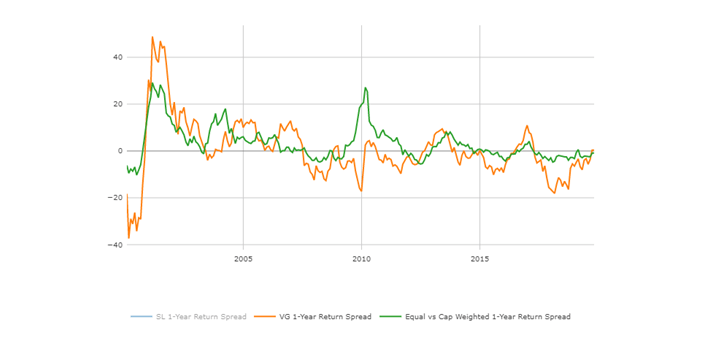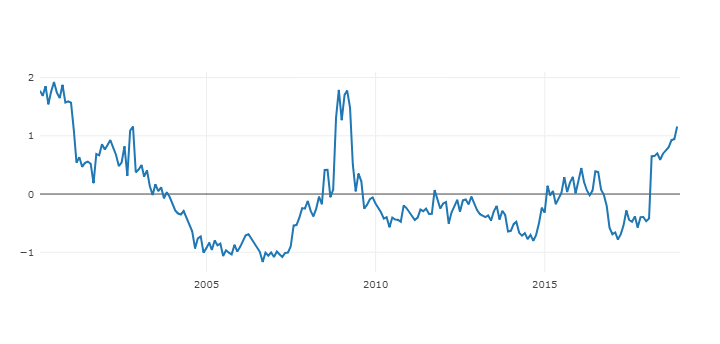
US economics, inflation, and the Fed
The U.S. inflation situation remains sticky. This was confirmed by the September readings on consumer and producer (wholesale) prices. Indeed, both the headline Consumer Price Index (CPI) and Producer Price Index (PPI) figures were stronger than expected, reflecting, in large part, the increase in energy costs. The core CPI and PPI, which exclude the more volatile food and energy components, moderated a bit. That was an encouraging sign for Federal Reserve officials, but the pace of price increases is still running well above the central bank’s target rate of 2%. Of note, a better-than-expected reading on September retail sales was an encouraging sign for leading retailers ahead of their latest quarterly results according to Value Line.
Treasury market yields recently hit levels not seen in more than 15 years. This may ultimately do the work for the Fed in its attempt to slow demand and put downward pressure on prices. While interest rates are likely to stay high for a longer period, we think that this can occur without additional hikes from the Federal Reserve before the end of this year. Investors should note that a mid-October Treasury market auction was very disappointing to the government and yields moved higher on the weaker demand for fixed-income securities.
Escalating geopolitical unrest is a concern for Wall Street. This includes the ongoing wars in the Middle East and Ukraine, as well as the mounting tension between China and Taiwan. JPMorgan Chase head Jamie Dimon recently opined that the geopolitical turmoil and rising interest-rate environment will have a far-ranging impact on energy and food markets, global trade, and geopolitical relationships.
Global economy
J.P. Morgan analysts have been revising up second half global growth forecasts consistently since midyear, and the latest data prompt a further significant revision. China delivered a sizeable upside GDP surprise, reporting for the third quarter of this year rising a robust 6.9% on an annual basis. Incoming US releases have been similarly impressive and have pushed their forecast for the third quarter US GDP to be up by 4.3%. Despite expectations of a Western Europe stall and contraction in Japan and Brazil, last quarter global GDP is projected to have advanced by 3.1%. The market participants have emphasized caution in extrapolating momentum and there are good reasons to expect global growth to decelerate toward a 2% annual rate gain this quarter. But the signals from recent news confirm the underlying resilience of the global expansion despite ongoing monetary restraint.
Stock market: Earnings here they come
The third-quarter earnings season got off to a good start. In particular, a number of the big money center banks, including JPMorgan Chase and Bank of America, surpassed revenue and earnings per-share forecasts. An overall solid performance from S&P 500 companies will likely be needed to justify their current valuations in a rising interest-rate environment. Since the summer, the 2s10s US Treasury curve has steepened by almost 60bp from very inverted levels. This has been driven by rising long-end yields, making it a bear steepening.
A bear steepener is the widening of the yield curve caused by long-term interest rates increasing at a faster rate than short-term rates. A bull steepener is characterized by short-term rates falling faster than long-term rates.
According to Goldman Sachs, such bear steepening has been one of the best environments for equities historically, as it reflects improving growth prospects. Consistent with this, Cyclicals, Small caps and Value tend to outperform while long duration growth stocks and defensives usually underperform. However, when the bear steepening is driven by rising real rates rather than a change in breakeven rates, equities typically struggle to rise and Cyclicals stop outperforming (Value consistently manages to outperform Growth).
Breakeven rate is the difference in yield between inflation-protected and nominal debt of the same maturity.
Goldman highlights several reasons why the bear steepening this time around might not be favorable for equities and Cyclicals:
- Currently, rising bond yields do not necessarily reflect better growth expectations, but rather rising term premium. This differs from the historical bear-steepening episodes that have all occurred after the Global Financial Crisis (GFC) when rising rates were considered a sign of receding deflation risks.
- The level from which rates are rising is already quite high, and a further increase in interest rates would likely weigh on equities and cyclicals.
- Equity valuations also do not look very attractive, with the equity risk premium down to 4%, a 15-year low. This means that there is less cushion for equities to digest higher rates.

In the short term the markets face uncertainties and may be pressured by the developments in the yield curve. We believe the best recipe in such conditions is to stick to fundamentally strong companies and to balance portfolios with healthy GARP and Value representation. At Signet, we continually seek to take advantage of investment opportunities and to rebalance our strategies accordingly. Recently we have rebalanced our proprietary Mid and Small Cap strategies emphasizing companies which consistently make money and experience steady growth.
With roughly 20% of S&P 500 companies reporting earnings, estimates are showing over a three-fourths beat rate, which is good according to Professor Siegel of Wharton Business School. There is some caution on the fourth quarter and the impact of higher rates, but nothing too serious yet. The stronger economy is supporting earnings growth in the fourth quarter and in 2024, which makes Professor Siegel bullish for 2024.
The information and opinions included in this document are for background purposes only, are not intended to be full or complete, and should not be viewed as an indication of future results. The information sources used in this letter are: WSJ.com, Jeremy Siegel, Ph.D. (Jeremysiegel.com), Goldman Sachs, J.P. Morgan, Empirical Research Partners, Value Line, BlackRock, Ned Davis Research, First Trust, Citi research, HSBC, and Nuveen.
IMPORTANT DISCLOSURE
Past performance may not be indicative of future results.
Different types of investments and investment strategies involve varying degrees of risk, and there can be no assurance that their future performance will be profitable, equal to any corresponding indicated historical performance level(s), be suitable for your portfolio or individual situation, or prove successful.
The statements made in this newsletter are, to the best of our ability and knowledge, accurate as of the date they were originally made. But due to various factors, including changing market conditions and/or applicable laws, the content may in the future no longer be reflective of current opinions or positions.
Any forward-looking statements, information, and opinions including descriptions of anticipated market changes and expectations of future activity contained in this newsletter are based upon reasonable estimates and assumptions. However, they are inherently uncertain, and actual events or results may differ materially from those reflected in the newsletter.
Nothing in this newsletter serves as the receipt of, or as a substitute for, personalized investment advice. Please remember to contact Signet Financial Management, LLC, if there are any changes in your personal or financial situation or investment objectives for the purpose of reviewing our previous recommendations and/or services. No portion of the newsletter content should be construed as legal, tax, or accounting advice.
A copy of Signet Financial Management, LLC’s current written disclosure statements discussing our advisory services, fees, investment advisory personnel, and operations are available upon request.



























































































